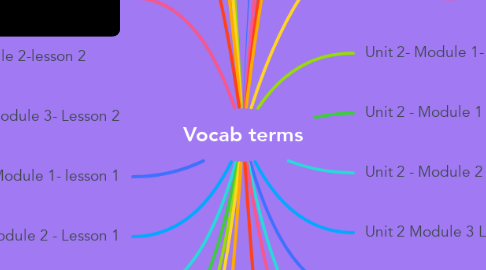
1. unit 1-module 1-lesson 1
1.1. Superposition
1.2. Original Horizontality
1.3. Lateral Continuity
1.3.1. Cross cutting relationships
1.4. Inclusions
1.5. The Fossil Record
1.6. Mass Extinctions
2. Reading 9/13
2.1. Unconformities
2.2. Correlation
2.3. index fossils
2.4. Key bed
2.5. Geologic time scale
3. Unit 1 - Module 1 - Lesson 2
3.1. Unconformities
3.2. Angular Unconformity
3.3. Disconformity
3.4. Nonconformity
4. Module 2, lesson 1
4.1. DNA Nucleotides
4.2. Nitrogenous Bases
4.3. Complementary Bases
4.4. DNA Models
4.5. How much DNA?
4.6. DNA Replication
4.7. Steps of DNA replication
4.8. Replication Fork
4.9. DNA Errors
4.10. helicase
4.11. Primase
4.12. DNA polymerase
4.13. Semi-Conservative Replication
4.14. leading strand
4.15. Lagging strand
4.16. Ligase
4.17. Mutations
4.18. Cancer
4.19. RNA
4.20. Uracil
4.21. Gene
4.22. Transcription
4.23. ribosomes
4.24. Translation
4.25. Amino acids
4.26. Codons
4.27. Anti-Codons
4.28. tRNA
4.29. Peptide Bonds
5. unit 1-module 2-lesson 2
5.1. Charles Darwin
5.1.1. Galapagos Islands
5.1.2. HMS beagle
5.1.3. Darwins finches
5.1.4. Natural selection
5.1.5. survival of the fittest
5.1.6. adaptations
5.1.7. fitness
5.1.8. genetic varaiation
5.1.9. common ancestors
5.1.10. strucuarl adaptation
5.1.11. behavioral adaptation
5.1.12. functional adaptation
5.1.13. Camouflage
5.1.14. Mimicry
5.1.15. Modern theory of evolution
6. Unit 1- Module 3- Lesson 2
6.1. Comparative Anatomy
6.2. Homologous Structures
6.3. Analogous Structures
6.4. Embryology
6.5. Molecular Biology
7. Unit 2-Module 1- lesson 1
7.1. reference point
7.2. Postition
7.3. Displacement
7.4. Speed
7.5. Average Speed
7.6. Velocity
7.7. Vector
7.8. Distance Time Graphs
8. Unit 2 - Module 2 - Lesson 1
8.1. Kinetic energy
8.2. Kinetic energy and mass
8.3. Kinetic energy and speed
9. Unit 2 - Module 2 - Lesson 3
9.1. Mechanical Energy
9.2. Conservation of energy
9.3. Thermal Energy Transformation
10. Unit 2- Module 3- Lesson 2
10.1. charges
10.2. Electric Fields
10.3. Electric Field Strength
10.4. Electric Potential Energy
10.5. Electrically charged objects
10.6. Electrically Neutral
10.7. Induction
10.8. Electric Insulator
10.9. Electric Conductor
10.10. Conduction
10.11. Conservation of Charge
11. Unit 2 Module 3 lesson 4
11.1. Electromagnetism
11.2. Electric Current
11.3. Magnetic Fields
11.4. Increasing Magnetic Field Strength
11.5. Controlling electromagnets
11.6. Electric Motor
11.7. Generating Electric Current
11.8. Electric Generator
11.9. Mechanical to electric energy
11.10. Direct Current
11.11. Alternating Current
12. Unit 3 module 1 lesson 2
12.1. Transmission
12.2. diffraction
12.3. reflection
12.4. absorption
13. Unit 4 - Module 1 - Lesson 1
13.1. population
13.2. Natural Resources
13.3. carrying capacity
14. Unit 2 - Module 2 - Lesson 3
15. Unit 1 - Module 1 - Section 5
15.1. Secondly, burning hair can lead to severe skin burns. Please tie hair back. Note: If the lab does not include a fire component, it is still important to tie hair back. It's not unheard of for students to accidently dip their hair into the chemicals with which they are working.
15.2. Clothing in a lab Footwear in a lab Protective Glasses Colors of Health Hazard symbols MSDS Pipetting
16. Unit 1 - Module 1 - Lesson 1
16.1. Uniformitarianism
16.2. Absolute Age
16.3. Relative-age dating
16.4. Sediment
16.5. Strata
17. Unit 1- Module 3-lesson 1
17.1. Fossil Formation
17.2. Mineralization
17.3. Carbonization
17.4. Molds and Casts
17.5. Trace Fossils
17.6. Original Material
17.7. Fossil Record
17.8. Geologic Time Scale
17.9. Extinctions
17.10. Sudden Environmental Change
17.11. Gradual Environmental Changes
17.12. Transitional Fossil
18. Unit 1- Module 2-lesson 3
18.1. Selective breeding
18.2. Genetic Engineering
18.3. Genetically modified organism
18.4. Natural selection
19. Scientific Method
19.1. The scientific method is an empirical method of acquiring knowledge that has characterized the development of science since at least the 17th century. It involves careful observation, applying rigorous skepticism about what is observed, given that cognitive assumptions can distort how one interprets the observation. And is all the steps that i'm about to repeat.
19.2. Observation
19.2.1. the action or process of observing something or someone carefully or in order to gain information.
19.3. Question
19.3.1. a sentence worded or expressed so as to elicit information.
19.3.2. Quantitative observations
19.3.2.1. A quantitative observation is an objective method of data analysis that measures research variables using numerical and statistical parameters.
19.4. Hypothesis
19.4.1. a supposition or proposed explanation made on the basis of limited evidence as a starting point for further investigation.
19.5. Iterative process
19.5.1. The iterative process is an approach to continuously improving a concept, design, or product.
19.6. Qualitative observations
19.6.1. Qualitative observation is a research method in which researchers collect data using their five senses, sight, smell, touch, taste, and hearing.
19.7. Test the Prediction
19.7.1. All predictions should be testable, meaning it should be possible to design an experiment that would verify or invalidate the prediction.
19.7.2. Prediction
19.7.2.1. a thing predicted.
19.8. Publish / Peer Review
19.8.1. The peer-review process subjects an author's scholarly work, research, or ideas to the scrutiny of others who are experts in the same field (peers) and is considered necessary to ensure academic scientific quality.
20. Unit 2- Module 1- Lesson 2
20.1. Acceleration
20.2. Forces
20.3. Contact Forces
20.4. Newtons 2nd Law of motion
20.5. Friction
20.5.1. the resistance that one surface or object encounters when moving over another.
